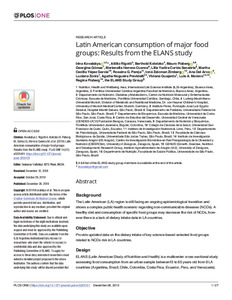Por favor, use este identificador para citar o enlazar este ítem:
https://repositorio.uca.edu.ar/handle/123456789/9871| Título: | Latin American consumption of major food groups : results from the ELANS study | Autor: | Kovalskys, Irina Rigotti, Attilio Koletzko, Berthold Fisberg, Mauro Gómez, Georgina Herrera Cuenca, Marianella Cortés Sanabria, Lilia Yadira Yépez García, Martha Cecilia Pareja, Rossina G. Zimberg, Ioná Zalcman Del Arco, Ana Zonis, Luciana Previdelli, Agatha Nogueira Guajardo, Viviana Moreno, Luis A. Fisberg, Regina Mara |
Palabras clave: | DIETA; ALIMENTACION; NUTRICION; AMERICA LATINA; ENFERMEDADES; SALUD | Fecha de publicación: | 2019 | Editorial: | Public Library of Science | Cita: | Kovalskys, I. et al. Latin American consumption of major food groups : results from the ELANS study [en línea]. PLoS ONE. 2019, 14(12). doi:10.1371/journal.pone.0225101 Disponible en: https://repositorio.uca.edu.ar/handle/123456789/9871 | Resumen: | Abstract: Background: The Latin American (LA) region is still facing an ongoing epidemiological transition and shows a complex public health scenario regarding non-communicable diseases (NCDs). A healthy diet and consumption of specific food groups may decrease the risk of NCDs, however there is a lack of dietary intake data in LA countries. Objective: Provide updated data on the dietary intake of key science-based selected food groups related to NCDs risk in LA countries. Design: ELANS (Latin American Study of Nutrition and Health) is a multicenter cross-sectional study assessing food consumption from an urban sample between15 to 65 years old from 8 LA countries (Argentina, Brazil, Chile, Colombia, Costa Rica, Ecuador, Peru, and Venezuela). Two 24-HR were obtained from 9,218 individuals. The daily intake of 10 food groups related to NCDs risk (fruits; vegetables; legumes/beans; nuts and seeds; whole grains products; fish and seafood; yogurt; red meat; processed meats; sugar-sweetened beverages (ready-to-drink and homemade)) were assessed and compared to global recommendations. Results: Only 7.2% of the overall sample reached WHO’s recommendation for fruits and vegetables consumption (400 grams per day). Regarding the dietary patterns related to a reduced risk of NCDs, among the overall sample legumes and fruits were the food groups with closer intake to the recommendation, although much lower than expected (13.1% and 11.5%, respectively). Less than 3.5% of the sample met the optimal consumption level of vegetables, nuts, whole grains, fish and yogurt. Largest country-dependent differences in average daily consumption were found for legumes, nuts, fish, and yogurt. Mean consumption of SSB showed large differences between countries. Conclusion: Diet intake quality is deficient for nutrient-dense food groups, suggesting a higher risk for NCDs in the urban LA region in upcoming decades. These data provide relevant and up-to-date information to take urgent public health actions to improve consumption of critically foods in order to prevent NCDs. | URI: | https://repositorio.uca.edu.ar/handle/123456789/9871 | ISSN: | 1932-6203 | Disciplina: | MEDICINA | DOI: | 10.1371/journal.pone.0225101 | Derechos: | Acceso abierto | Fuente: | PLoS ONE. 2019, 14(12) |
| Appears in Collections: | Artículos |
Files in This Item:
| File | Description | Size | Format | |
|---|---|---|---|---|
| latin-american-consumption-major.pdf | 1,53 MB | Adobe PDF |  View/Open |
Page view(s)
370
checked on Dec 5, 2025
Download(s)
254
checked on Dec 5, 2025
Google ScholarTM
Check
Altmetric
Altmetric
This item is licensed under a Creative Commons License

